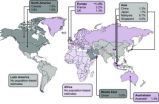(Press-News.org) PROVIDENCE, R.I. [Brown University] — It's hard to comprehend how bad the current rate of species extinction around the world has become without knowing what it was before people came along. The newest estimate is that the pre-human rate was 10 times lower than scientists had thought, which means that the current level is 10 times worse.
Extinctions are about 1,000 times more frequent now than in the 60 million years before people came along. The explanation from lead author Jurriaan de Vos, a Brown University postdoctoral researcher, senior author Stuart Pimm, a Duke University professor, and their team appears online in the journal Conservation Biology.
"This reinforces the urgency to conserve what is left and to try to reduce our impacts," said de Vos, who began the work while at the University of Zurich. "It was very, very different before humans entered the scene."
In absolute, albeit rough, terms the paper calculates a "normal background rate" of extinction of 0.1 extinctions per million species per year. That revises the figure of 1 extinction per million species per year that Pimm estimated in prior work in the 1990s. By contrast, the current extinction rate is more on the order of 100 extinctions per million species per year.
Orders of magnitude, rather than precise numbers are about the best any method can do for a global extinction rate, de Vos said. "That's just being honest about the uncertainty there is in these type of analyses."
From Fossils to Genetics
The new estimate improves markedly on prior ones mostly because it goes beyond the fossil record. Fossils are helpful sources of information, but their shortcomings include disproportionate representation of hard-bodied sea animals and the problem that they often only allow identification of the animal or plant's genus, but not its exact species.
What the fossils do show clearly is that apart from a few cataclysms over geological periods — such as the one that eliminated the dinosaurs — biodiversity has slowly increased.
The new study next examined evidence from the evolutionary family trees — phylogenies — of numerous plant and animal species. Phylogenies, constructed by studying DNA, trace how groups of species have changed over time, adding new genetic lineages and losing unsuccessful ones. They provide rich details of how species have diversified over time.
"The diversification rate is the speciation rate minus the extinction rate," said co-author Lucas Joppa, a scientist at Microsoft Research in Redmond, Wash. "The total number of species on earth has not been declining in recent geological history. It is either constant or increasing. Therefore, the average rate at which groups grew in their numbers of species must have been similar to or higher than the rate at which other groups lost species through extinction."
The work compiled scores of studies of molecular phylogenies on how fast species diversified.
For a third approach, de Vos noted that the exponential climb of species diversity should take a steeper upward turn in the current era because the newest species haven't gone extinct yet.
"It's rather like your bank account on the day you get paid," he said. "It gets a burst of funds — akin to new species — that will quickly become extinct as you pay your bills."
By comparing that rise of the number of species from the as-yet unchecked speciation rate with the historical trend (it was "log-linear") evident in the phylogenies, he could therefore create a predictive model of what the counteracting historical extinction rate must have been.
The researchers honed their models by testing them with simulated data for which they knew an actual extinction rate. The final models yielded accurate results. They tested the models to see how they performed when certain key assumptions were wrong and on average the models remained correct (in the aggregate, if not always for every species group).
All three data approaches together yielded a normal background extinction rate squarely in the order of 0.1 extinctions per million species per year.
A Human Role
There is little doubt among the scientists that humans are not merely witnesses to the current elevated extinction rate. This paper follows a recent one in Science , authored by Pimm, Joppa, and other colleagues, that tracks where species are threatened or confined to small ranges around the globe. In most cases, the main cause of extinctions is human population growth and per capita consumption, although the paper also notes how humans have been able to promote conservation.
The new study, Pimm said, emphasizes that the current extinction rate is a more severe crisis than previously understood.
"We've known for 20 years that current rates of species extinctions are exceptionally high," said Pimm, president of the conservation nonprofit organization SavingSpecies. "This new study comes up with a better estimate of the normal background rate — how fast species would go extinct were it not for human actions. It's lower than we thought, meaning that the current extinction crisis is much worse by comparison."
INFORMATION:
Other authors on the paper are John Gittleman and Patrick Stephens of the University of Georgia.
Extinctions during human era worse than thought
2014-09-02
ELSE PRESS RELEASES FROM THIS DATE:
Time to take notice and tackle heart failure
2014-09-02
Experts have sounded a call to action for policy makers at local, national, and international levels to promote heart failure prevention, improve heart failure awareness among healthcare professionals, ensure equity of care for all patients with heart failure, support and empower patients and their caregivers, and promote heart failure research.
Despite the increasing numbers of people living with and dying from heart failure, awareness of the disease is low among the public, politicians, and even some healthcare professionals. Although there is no cure for heart failure, ...
Chinese scientists' team efforts in dissecting rice complex agronomic traits in recent years
2014-09-02
Rice is a main food source for more than half of the global population and is a model plant for genome-based research.
Since the turn of the century, Chinese scientists have embarked on a "Long March" toward more intricate understanding of the complex agronomic traits of rice, spurred in part by the completion of the draft genome sequence of the indica variety 93-11 and a fine sequence analysis of chromosome 4 of the japonica variety Nipponbare.
These researchers "have made crucial contributions to international efforts in sequencing the rice genome," report Jianru Zuo ...
Childhood trauma could lead to adult obesity
2014-09-02
Being subjected to abuse during childhood entails a markedly increased risk of developing obesity as an adult. This is the conclusion of a meta-analysis carried out on previous studies, which included a total of 112,000 participants. The analysis was conducted by researchers at Karolinska Institutet in Sweden, and has been published in the journal Obesity Reviews.
"The study clearly shows that difficult life events leave traces which can manifest as disease much later in life. The mechanisms behind this process include stress, negative patterns of thought and emotions, ...
Scientists obtain new data on the weather 10,000 years ago from sediments of a lake in Sierra Nevada
2014-09-02
A research project which counts with the participation of the University of Granada has revealed new data on the climate change that took place in the Iberian Peninsula around the mid Holocene (around 6.000 years ago), when the amount of atmospheric dust coming from the Sahara increased. The data came from a study of the sediments found in an Alpine lake in Sierra Nevada (Granada)
This study, published in the journal Chemical Geology, is based on the sedimentation of atmospheric dust from the Sahara, a very frequent phenomenon in the South of the Iberian Peninsula. This ...
Muslim headscarf may buffer against negative body image among women
2014-09-02
Researchers have found that British Muslim women who wear a hijab generally have more positive body image, are less reliant on media messages about beauty ideals, and place less importance on appearance than those who do not wear a hijab. These effects appear to be driven by use of a hijab specifically, rather than religiosity.
"While we shouldn't assume that wearing the hijab immunizes Muslim women from negative body image, our results do suggest that wearing the hijab may help some women reject prescriptive beauty ideals," said Dr. Viren Swami, lead author of the British ...
In pro baseball pitchers, weak core linked to more missed days
2014-09-02
COLUMBUS, Ohio – New research suggests that professional baseball pitchers with poor core stability are more likely to miss 30 or more days in a single season because of injury than are pitchers who have good control of muscles in their lower back and pelvis.
In the study, 347 pitchers were assessed for lumbopelvic control during spring training. Pitchers with more tilt in their pelvis as they raised a leg to step up were up to three times more likely to miss at least 30 days – cumulative, not consecutive – during the season than were pitchers who showed minimal tilt ...
Throwing a loop to silence gene expression
2014-09-02
All human cells contain essentially the same DNA sequence – their genetic information. How is it possible that shapes and functions of cells in the different parts of the body are so different? While every cell's DNA contains the same construction master plan, an additional regulatory layer exists that determines which of the many possible DNA programs are active. This mechanism involves modifications of genome-bound histone proteins or the DNA itself with small chemical groups (e.g. methylation). It acts on top of the genetic information and is thus called 'epi'-genetic ...
Mechanical ventilation a key indicator for pre-term children's math problems
2014-09-02
A new study, led by researchers at the University of Warwick in the UK and the Ruhr-University Bochum in Germany, and just published in the Journal Early Human Development, has found that both the length of time spent in hospital after birth and the use of mechanical ventilation are key indicators of reduced mathematical ability in preterm children.
Mathematic abilities are crucial for lifelong academic attainment. Impairments in mathematic abilities are common in very preterm children. Earlier studies of children who are born very preterm (before 32 weeks of gestational ...
What you eat and not just the number of calories, is a significant factor in diabetes risk
2014-09-02
If you think losing weight is enough to prevent Type 2 diabetes, don't get your hopes up. A new research report in September 2014 issue of The FASEB Journal, suggests that you don't have to be overweight to develop Type 2 diabetes. This study compared genetically identical twins-one heavier and one leaner-and found that after eating a fast-food meal, the circulating metabolites, including those related to Type 2 diabetes, were found in both individuals at the same levels. These findings suggest that the onset of this type of diabetes is largely influenced by genetic factors ...
Ben-Gurion University researchers develop new program to evaluate prominent individuals' personalities
2014-09-02
BEER-SHEVA, ISRAEL…September 2, 2014 – Researchers at Ben-Gurion University of the Negev have developed a new program that automates classification of personality traits of prominent individuals -- both friend and foe -- according to a paper soon to be published in the American Intelligence Journal.
"This new field, termed 'Computational Personality,' gives us the ability to better understand the minds of military and political leaders, which is an important aspect of strategic intelligence," explains BGU Prof. Yair Neuman of the Homeland Security Institute. "Psychologists ...




